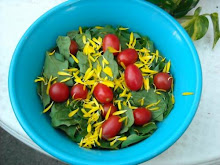
Q. I am starting a garden! At least I've bought some seeds and some starter plants: broccoli, tomato & cabbage. I've been learning little things along the way: you can plant a whole potato & the number of eyes it has is the number of potatoes you can potentially get.
But here's the thing. A friend of mine asked me if I had toilable land or something like that? I think she meant if it was good ground to plant in...and then I realized. I have no idea! Holy crap! I've bought plants and seeds & I don't even know if my ground is fertile! I mean, there's grass, does that mean it will support my veggies? If you have any resources you'd like to refer me to, so you don't have to answer all of my amateur questions, feel free.
Oh and btw, do you think I should get a Farmer's Almanac?
Sincerely,
Stuck between a hoe and a hard place.
((ha ha ha)):: Wouldn't that be awesome if you started a blog where you could answer questions like mine? You could totally call yourself the Gardening Ninja. Folks would love that shit!
A. Excellent questions . . . by the way, the number of eyes on a potato is the number of potato PLANTS you'll get from it--you should cut the potato into chunks, each chunk containing at least one eye, before you plant it.
If you're tearing up your lawn, chances are you have so/so soil. It may be compacted and depleted, and chances are that when your building was constructed the workers just threw whatever clay, rock, etc. they had left over out front and called it a yard. That's standard practice. The good news: you've got to start somewhere, and that's as good a place as any! Dig deep, break up major clumps, and add as much organic material as possible. Ideally, compost and lots of it (raided from gardening friends--if I was around, I'd give you a bunch--or purchased in a bag from Lowe's; it's not cheating, I swear), but really ANYTHING you can add to loosen the dirt up a little will get microbes, enzymes, earthworms, etc., started on what they do best, which is create kick-ass soil for you. Grass clippings (sans herbicides, of course), finely shredded newspaper or other materials, layers of cardboard, hay, coffee grounds . . . etc, etc. If you have potted stuff that's done, you can dig in a bunch of leftover potting soil. Chop stuff up as fine as possible, mix it well, and water it to keep it moist if there's not rain.
I just caught myself getting ready to head off into a giant tangent about sheet composting and lasagna gardening, but stopped myself at the last minute. ;) Getting better about that!
You should not get a Farmer's Almanac. I have extras, and will bring you one! Um. Text me during that first week or so of May and remind me.
What you SHOULD get is a subscription to Mother Earth News, $10 at their website. And/or continue to pick my brain, as it's full of the same info, but without the pretty pictures. ;)
Hmmmm. I may have to do that blog thing . . . :ponders:. Sounds fun, actually!
Let me know if any of the above helps, or if you have other questions!
Always,
The Garden Ninja
More Info/Follow-Up: I know everybody's first question is "Why didn't you suggest raised beds?" . . . and my answer, once I get done with the rude hand gestures at the peanut gallery, is this: I know the questioner in this case to be an extremely overscheduled young woman; if she has time to stuff a few plants into the ground, I'm impressed. Figuring out good spots for raised beds and constructing something to contain them (yes, you can do them without containment; I strongly prefer them with it as it delays their inevitable return to a level state and provides a nice visual barrier), filling them to the brim with good soil, etc., is simply not going to happen.
It's better to start small than to never start at all.


No comments:
Post a Comment